#automation IP
Explore tagged Tumblr posts
Text
Valuing Intellectual Property | A New Challenge for Industrial Estimating Services
Introduction As industrial sectors evolve through digitalization, automation, and innovation, intellectual property (IP) has become one of the most valuable assets within a project. From proprietary software and patented designs to custom manufacturing processes and smart technologies, IP is reshaping how value is created and assessed. However, traditional industrial estimating services—built around physical materials, labor, and equipment—are now faced with a complex challenge: how to accurately estimate the cost and value of intellectual property within industrial projects.
This emerging frontier calls for a redefinition of scope in industrial estimating services, expanding their role to account for intangible assets that drive both performance and competitive advantage.
Why IP Matters in Industrial Cost Estimation In many modern industrial developments, especially in high-tech manufacturing, advanced energy systems, and Industry 4.0-enabled factories, intellectual property comprises a significant portion of overall value. For instance:
A custom automation algorithm embedded in a robotics line
Proprietary energy-efficiency systems in a chemical plant
Secure software platforms for controlling distributed manufacturing
These IP-driven elements often represent a large portion of R&D investment and are critical to long-term operational efficiency. An accurate estimate must include not just the cost to implement or license such assets but also the potential risk, return, and lifecycle value they bring.
Key Categories of Intellectual Property in Industrial Settings Understanding how IP appears in industrial projects is essential for accurate estimation. Common categories include:
Patents: Inventions or processes owned or licensed by the project owner
Trade Secrets: Confidential formulas or methods applied during production
Software and Algorithms: Custom-coded tools used in automation and process control
Design Rights: Proprietary architectural or engineering designs
Licenses and Royalties: Payments made to third parties for the use of protected IP
Each of these categories demands unique valuation methods and estimation strategies that differ from traditional capital expenditures.
Challenges in Estimating IP Costs Valuing IP in industrial settings is inherently complex due to:
Intangibility: Unlike steel or labor hours, IP has no physical form and often lacks clear benchmarks.
Variable Cost Structures: Licensing fees, development costs, and long-term support vary widely by industry and supplier.
Lifecycle Uncertainty: IP might evolve or become obsolete quickly, adding estimation risk.
Confidentiality: Many IP assets are guarded by NDAs or corporate secrecy, limiting estimator access.
As a result, industrial estimating services must blend financial modeling, legal review, and technical expertise to deliver accurate assessments.
Approaches to Integrating IP into Estimates To manage these complexities, forward-thinking estimating services apply several strategies:
Cost-Based Estimation: Involves calculating the original R&D or development costs and applying a markup based on projected use.
Market-Based Valuation: Uses comparative licensing or sales data for similar IP assets, when available.
Income-Based Modeling: Projects future cash flows generated by the IP (e.g., operational savings, productivity gains) and discounts them to present value.
Expert Collaboration: Engaging IP lawyers, technology consultants, and accountants to accurately categorize and value protected assets.
Case Example: Estimating an Advanced Robotics System A manufacturing client planned to install a robotics line powered by proprietary AI software developed in-house. While the hardware had clear market prices, the software’s value was harder to define. The industrial estimating service worked with internal developers and finance experts to model the cost of development, anticipated efficiency savings over ten years, and licensing potential if the software was reused across other sites.
By incorporating both direct and indirect value contributions, the estimate provided a holistic picture that helped justify a higher upfront investment.
Benefits of IP-Savvy Estimating Industrial clients gain several advantages when IP is accurately included in estimates:
More Realistic Budgets: Avoids underbudgeting by recognizing the full cost of IP integration or licensing.
Stronger Business Cases: Supports ROI projections for innovation-driven projects.
Better Risk Assessment: Helps identify where IP exposure (e.g., licensing dependencies) may affect project costs.
Investor Appeal: Demonstrates comprehensive valuation, which is critical for attracting investment in innovation-heavy projects.
New Tools and Trends As the demand grows, some industrial estimating platforms are adapting to include IP modeling features:
Digital Asset Registries: Help track owned or licensed IP within the project scope.
AI-Powered Valuation Engines: Use historical and market data to suggest value ranges.
Blockchain for IP Tracking: Ensures provenance and licensing status of digital IP in complex supply chains.
These innovations indicate that IP valuation is becoming a mainstream requirement in industrial estimating practices.
Limitations and Ongoing Development Despite advances, valuing IP remains a partly subjective exercise. The uniqueness of each asset and the lack of standard benchmarks can introduce variability. Moreover, legal changes—such as patent law shifts or tax implications—can alter value significantly.
Estimating services must remain adaptive, continuously updating models and methodologies to reflect both technical and legal developments.
Conclusion The rise of intellectual property as a strategic asset in industrial projects is reshaping the landscape for estimating services. No longer confined to bricks, pipes, and wires, estimators must now navigate code, algorithms, and trade secrets. By embracing this challenge, industrial estimating services not only improve budget accuracy but also elevate their strategic role in capital planning and innovation management. The result is a more holistic view of project value—one that aligns with the digital age.
#industrial estimating#intellectual property#IP valuation#industrial projects#cost estimation#IP assets#software cost#patent cost#innovation budgeting#intangible assets#ROI modeling#licensing fees#proprietary software#automation IP#manufacturing IP#trade secrets#digital asset valuation#tech integration#income-based estimation#market-based estimation#IP in construction#software estimation#R&D cost#risk analysis#estimating strategy#lifecycle cost#future-proofing#estimating service tools#high-tech estimating#cost planning
0 notes
Text
I really don't want to get into big discussions about AI tbh, but it strikes me how currently most of the criticisms drawn against it fall into the same handful of pitfalls.
- "it's theft!" which relies on a view where information is property, and as such needs to be safeguarded through IP laws (as if IP laws had ever protected the small artist against the corpos), which people don't really care about anyway(*)
- "it sucks!"/"anybody can see it's ai" which concedes defeat as its formulated, because "not good enough" implies "if it was, there'd be no issue" and we all know that's not true, on the contrary the better quality the more present the issues
- "there's no soul in it!" which is similar but also always leads to "what is art?"-style debate (hasn't been settled in the last 500yrs and probs won't for the next 500 either) and can be ignored by just going "good for you, I enjoy it tho so what's it to you?"
I guess some of it sticks on ppl you wouldn't have convinced otherwise, but man, there's some Bad Opinions in there.
#(*: and imo they're right on that one - IP law is a poison)#don't find yourself turning reactionary just bc the thing you don't like happens to be new#i feel the ecological arguments and worker's rights arguments are way more sound#and i dont really want to write any more than this on the topic tbh but if you eant my actual opinion:#ai is less the crux of the actual issue and we're just face to face with the problem of efficiency and automation in a capitalist society#anyway
7 notes
·
View notes
Text

In this blog post, we’ll look at how automation can streamline operations and drive revenue growth across the hospitality sector—so read on to find out more!. Learn More...
#cloud technology#automation#ai automation#hotel hospitality#hotel pbx#ip telephony#unified communications#hotel phone system#phonesuite pbx#phonesuite voiceware#hotel phone installation#voiceware by phonesuite#hotel industry#Hotel hospitality#elephony
9 notes
·
View notes
Text
What makes Satisfactory so (haha) satisfying are those moments when you get to see your production line working the way you want it to
And I say that as a player that does not optimize their production lines at all (hence why I am currently suffering a shortage of cables and modular frames in my main factory)
Anyway, I spent the last few hours building a turbo fuel plant and it succeeded the test of going online and that made me very happy
(now to add enough generators to actually use all that fuel I am producing, I only put down 8 so far, and used geysers and power buffers to start up the factory)
#shut up ip#the funny thing is for this power plant I actually did the math of how many refinieries and co are needed etc#and then looked at the number and went your uneven fuck off#so essentially I am underutilizing the oil nodes and everything else by extension#i will probably use this factory for nobelisk and ammo automation as well since I handcrafted those before#satisfactory
3 notes
·
View notes
Text
I hate AI
AI is nothing more than a bunch of cyber bros masturbating over how they can now kill their english teacher who tried to teach them how to read and understand things. "Oh you can use it to summarize meeting" "You can use it to look up things" "Oh you are starting a Podcast about history? How are you using AI?" My job is integrating it on the back end and with that I can't opt out of it. Plus they never think about how if you need fewer people, then there are fewer jobs and therefore, fewer people who use your products BECAUSE THEY LITERALLY CAN'T AFFORD IT. I hate all of this all the time. I can't wait until it dies. At least my job is taking about how expensive it is so if people don't use it it's a waste. Guess what I will not use willingly!
#Anti AI#Like I get it when it comes to stuff like google maps#Or to automate repetitive demanding and dangerous tasks#But that is not at all how it's being used here#Plus the massive energy usage#Just... so much#It needs to go#now#I'm not touching the IP issues because that is a related but thorny issue
4 notes
·
View notes
Text
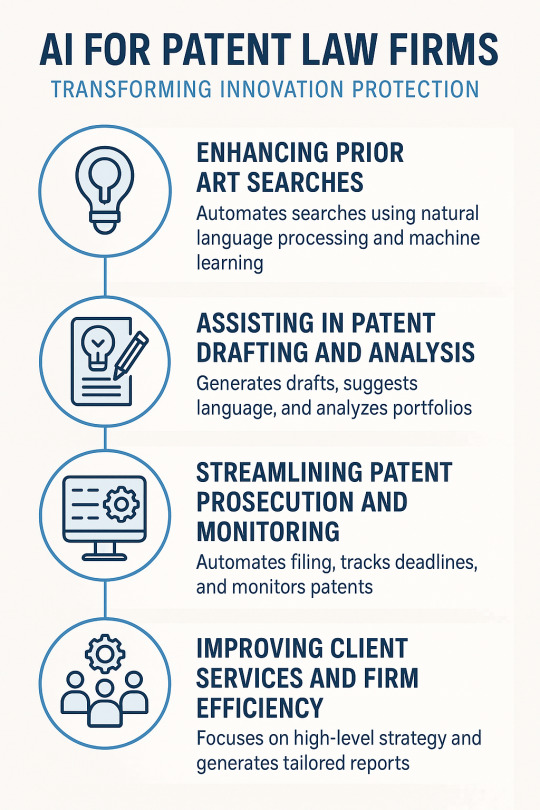
AI for Patent Law Firms: Transforming Innovation Protection
In recent years, artificial intelligence (AI) has made significant inroads into the legal profession, and patent law firms are among the most promising beneficiaries. From automating prior art searches to drafting patent applications and streamlining portfolio management, AI is transforming how intellectual property (IP) professionals operate. As innovation accelerates globally, AI is proving indispensable in helping patent attorneys manage increasing workloads while maintaining the precision and strategic foresight that the field demands.
1. Enhancing Prior Art Searches
One of the most time-consuming tasks in patent prosecution is conducting thorough prior art searches. Traditionally, this required manually sifting through thousands of patent documents and scientific publications. Today, AI-powered search tools—leveraging natural language processing (NLP) and machine learning algorithms—can scan vast databases in seconds and return highly relevant results. These tools understand context and can identify similar inventions even when keywords differ, greatly improving both the speed and accuracy of search results. This enables attorneys to build stronger patent claims and avoid costly litigation risks.
2. Assisting in Patent Drafting and Analysis
AI is increasingly being used to assist in drafting patent applications by generating first drafts based on input claims and invention disclosures. While human oversight remains essential, AI tools can structure documents, suggest language based on existing patents, and even highlight inconsistencies or vague terminology. This not only accelerates the drafting process but also helps ensure compliance with the rigorous standards set by patent offices like the USPTO and EPO.
Moreover, AI tools can analyze existing patent portfolios to identify gaps, potential invalidity risks, or infringement threats. This enables firms to provide clients with strategic advice grounded in real-time data and comprehensive patent landscape analysis.
3. Streamlining Patent Prosecution and Monitoring
Patent prosecution involves extensive communication with patent offices, which can be delayed by human bottlenecks. AI can automate much of this process, including filing forms, tracking deadlines, and managing office actions. It can also analyze examiner behavior patterns to predict outcomes or suggest alternative claim strategies, giving firms a competitive edge.
Furthermore, AI can monitor granted patents and publications globally, alerting attorneys to competitor filings or infringement risks. Such capabilities are invaluable in sectors like biotechnology, software, and telecommunications, where overlapping IP rights are common.
4. Improving Client Services and Firm Efficiency
AI also empowers patent law firms to offer more value-driven services. By automating routine tasks, attorneys can focus more on high-level strategy and client engagement. AI-based tools can generate reports, dashboards, and risk assessments tailored to client needs, improving transparency and decision-making. Additionally, AI supports scalable operations, making it easier for firms to serve startups and large enterprises alike with consistent quality.
AI is not replacing patent attorneys—it’s empowering them. By enhancing efficiency, accuracy, and strategic insight, AI is becoming a vital partner in the practice of patent law. Forward-thinking firms that embrace AI are better positioned to navigate the complexities of modern IP management and deliver superior outcomes for their clients. As the legal tech landscape evolves, AI will play a central role in shaping the future of patent protection and innovation strategy.
Read More:
Here're The 10 Best AI Tools for Patent Drafting in 2025
#AI for patent law firms#patents#innovation#AI patent assistant#automated patent drafting#IP automation tool
0 notes
Text
#NORD DRIVESYSTEMS#EtherNet/IP#ConveyorSystems#Automation#Industry40#FoodPackaging#TCO#Sustainability#Timestech#electronicsnews#technologynews
0 notes
Text
Enhancing Textile Machinery Efficiency with Messung's NX-ERA Xpress PLC

The textile industry, being a part of global manufacturing, has witnessed a massive transformation in recent years due to accelerated technological advancements. From yarn making to dyeing yarns with complex patterns, each process of textile production has been streamlined for higher productivity, accuracy, and efficiency. The need for high-quality products and shorter production cycles has generated fertile ground for automation, especially with the use of Programmable Logic Controllers (PLCs)in textile manufacturing.
This is where we at Messung Industrial Automation come in the picture with our cutting-edge automation solutions. With our strong heritage of delivering strong and scalable automation solutions, we have been the industry leader in industrial automation. Our innovative and compact PLC, NX-ERA Xpress has been crafted to specifically address the specific requirements of industries such as textile manufacturingwith the ideal combination of performance, flexibility, and energy efficiency. In this blog, let’s explore the revolutionary potential of NX-ERA Xpress PLCand its impact on textile machinery, with an emphasis on how it improves operational efficiency, cuts costs, and accelerates the journey towards Industry 4.0.

The Role of PLCs in Modern Textile Manufacturing
Programmable Logic Controllers (PLCs) form the foundation of automation in textile manufacturing, especially in the "cotton to yarn" and "yarn to fabric" segments where their role is most critical. These rugged, industrial-grade controllers ensure precision, speed, and efficiency by managing machinery and processes in real time. From ginning and bale plucking to spinning, carding, drawframe, combing, ring frame machines, and autoconers, PLCs are deeply embedded in every stage of the cotton-to-yarn journey.
In the yarn-to-fabric sector, PLCs continue to play a significant role in the operation of warping machines, twisting machines, and various types of looms such as shuttle, airjet, and rapier looms. They are equally vital in fabric processing lines, managing singeing, bleaching, dyeing, and a wide range of finishing machines designed to enhance textile properties like softness, wrinkle resistance, or water repellency. Printing lines, including rotary and flat bed printing machines, also rely heavily on PLC-controlled automation.
Across these applications, PLCs are integrated with Human Machine Interfaces (HMI), Variable Frequency Drives (VFDs), and in high-speed machines like spinning lines, Servo amplifiers and Servo motors are used for superior speed and torque control.
While the garment sector (fabric to garment) does involve automation, Messung’s core expertise and solutions, including the NX-ERA Xpress PLC and NX-ERA Jet PLC, are primarily focused on the earlier and more automation-intensive stages of textile manufacturing.
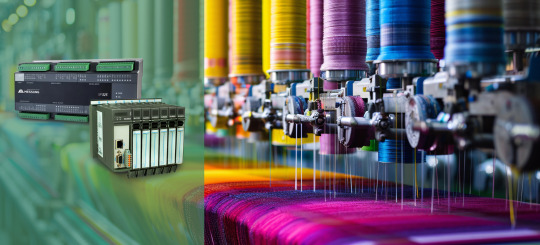
Benefits of Implementing PLCs on Textile Machinery
Increased Efficiency: PLCs allow streamline operations by automating processes that were previously manual, significantly reducing downtime and increasing throughput
Improved Accuracy: The high-level precision control afforded by PLCs ensures each activity in the fabric process, whether spinning or weaving, is undertaken with perfection.
Real-Time Monitoring: PLC-based systems make equipment monitoring in real-time a certainty, where defects are flagged off early and avoid costly downtime along with plant operation performance improvements.
As the textile industry advances, compact PLCs are not an indulgence but a must-have. Automation is the key to staying competitive, and industrial automation PLC systems like the NX-ERA Xpress are at the forefront of this revolution.
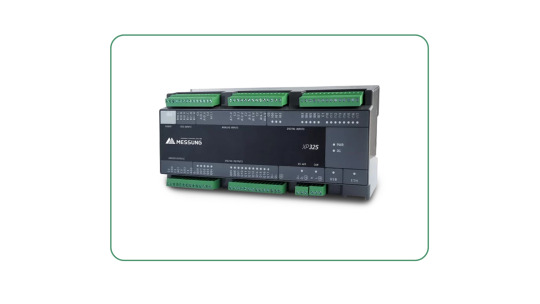
Learning More About NX-ERA Xpress PLC
The NX-ERA Xpress PLC is our response to the increasing needs of the textile industry. By harnessing the capability of Programmable Logic Control Systems and the flexibility of contemporary communication protocols, the NX-ERA Xpress provides a powerful and scalable solution for numerous industrial automation applications.
Features of NX-ERA Xpress PLC:
High-Density Digital and Analog I/O: The NX-ERA Xpress PLC features a high-density I/O design that is capable of processing vast amounts of data input and output at one time. This is important for the textile industry, where real-time data from many machines need to be processed efficiently in order to optimize performance.
Programming through Codesys® (IEC 61131 Standard): Among the most impressive aspects of the NX-ERA Xpress PLC is its support for Codesys®, an open-source programming platform. This standardization enables seamless integration with industrial equipment across the board, which makes it an attractive option for PLC manufacturing companies.
Integrated Communication Protocols: With inbuilt compatibility for communication protocols such as Ethernet TCP/IP, Modbus, and CANopen, the NX-ERA Xpress PLC facilitates smooth connectivity among various machines and devices on the shop floor. This connectivity is vital for ensuring smooth operation throughout the complete manufacturing process.
Industry 4.0 Readiness: NX-ERA Xpress PLC comes with OPC-UA and MQTT readiness, making it Industry 4.0-ready. These are technologies that support data exchange over different platforms, and they simplify the integration of machines by manufacturers into a smart factory environment.
Integrated HTML Web Server for Remote Monitoring: Remote monitoring has never been simpler. The integrated HTML web server enables operators to monitor and control the PLC remotely, offering flexibility and real-time visibility into machine performance.
The high-performance features and compact PLC design of NX-ERA Xpress PLC make it perfect for the textile industry. Whether you're automating cotton spinning, weaving, or dyeing, the NX-ERA Xpress provides all the power you need to optimize your operations.
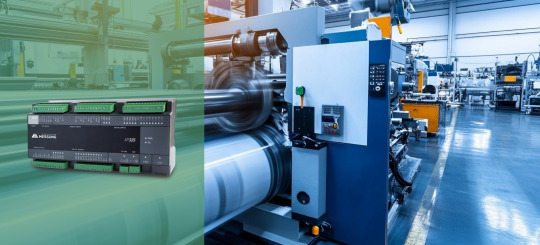
Advantages of NX-ERA Xpress in Textile Applications
The textile industry requires solutions that are capable of providing not just high performance but also cost-effectiveness and sustainability. Our NX-ERA Xpress PLC provides a number of benefits for applications in textile machinery, such as:
Energy Efficiency
In the textile industry, energy consumption is a major operational expense. The NX-ERA Xpress PLC is built to maximize control and minimize power consumption, especially in power-hungry processes such as spinning. Through automation processes and optimizing machine efficiency, the PLC ensures textile plants make substantial savings on energy.
High-Speed Processing
Textile production processes often involve rapid and adaptive control systems that are necessary for handling high-speed manufacturing lines. The processing of high speeds facilitated by the NX-ERA Xpress PLC helps data move faster to provide instant adjustment capabilities, ensuring minimum lags in manufacturing processes.
Precision Control
The clothing industry is based on the effective control of variables like thread tension, fabric alignment, and dying processes. NX-ERA Xpress PLC ensures accurate control in order to match every parameter in the manufacturing process to the prescribed specifications. The result is repetitive product quality, and less it is defective.
Scalability
As textile factories develop and expand, scalable automation systems become increasingly relevant. NX-ERA Xpress PLC uses a modular construction that means that automation systems can be expanded as they are required by manufacturers, presenting a great solution for expanding businesses in the textile industry in the long term.
Cost-Effectiveness
Automation must not be expensive. The NX-ERA Xpress PLC is an affordable solution for textile producers that offers high-end features without an exorbitant price tag. It is meant to offer high-performance at an affordable rate, so any textile firm can use it.

Textile Machinery Applications: PLC Precision for a Modern Mill
As textile factories embrace digital transformation, the NX-ERA Xpress PLC emerges as a compact yet powerful solution tailored for automation-ready textile machinery. With its robust control features and Industry 4.0 connectivity, the NX-ERA Xpress brings intelligence and agility to a wide range of textile processes.
Let’s explore key use cases across the textile value chain:
Yarn Steaming Machine:
Steaming is a critical stage in yarn preparation where temperature, pressure, and timing must work in harmony. The NX-ERA Xpress PLC ensures:
Precise control of temperature and steam pressure for consistent yarn conditioning
Regulation of steaming duration to match different yarn types and production speeds
Automation of loading and unloading mechanisms, reducing manual intervention and boosting throughput
With its real-time responsiveness and compact design, the NX-ERA Xpress PLC enhances efficiency, consistency, and reliability in yarn steaming operations.
Heat Setting and Space Dyeing Machine Integration:
In advanced textile finishing, seamless integration between heat setting and dyeing is essential. NX-ERA Xpress PLC brings synchronization and control to:
Temperature management for precise heat setting, improving dimensional stability and dye fixation
Control of dye application in the space dyeing process, enabling unique patterns with consistent results
Coordination of material flow between machines, ensuring smooth transitions and avoiding process bottlenecks
The result is an integrated, high-performance workflow for specialty dyeing applications, digitally governed for optimal output and reduced waste.
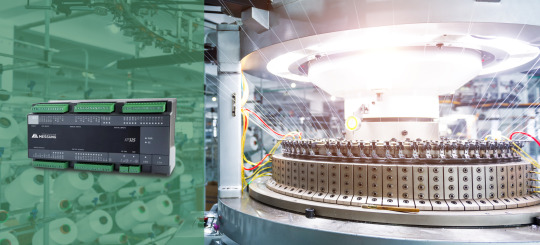
Integration with Messung's Automation Ecosystem
One of the major strengths of the NX-ERA Xpress PLC is that it can integrate smoothly with all our other products, like the XM-PRO remote I/O modules. This makes it possible to have a unified automation solution that simplifies the control and monitoring of your entire textile plant.
With a single provider for all automation needs, textile manufacturers can enjoy streamlined operations, reduced complexity, and improved support. The synergy between the NX-ERA Xpress PLC and our other products ensures that your factory is fully equipped to tackle the challenges of modern textile manufacturing.
Conclusion
In summary, our NX-ERA Xpress PLC is a game-changer in the textile sector, providing powerful, scalable, and affordable automation. With its high-performance capabilities, energy efficiency, and accurate control, the NX-ERA Xpress PLC is ideally positioned to address the changing needs of textile producers.
With the NX-ERA Xpress PLC, you can elevate your textile manufacturing process to the next level. Whether you want to optimize spinning, weaving, or dyeing processes, Messung's automation solutions provide the reliability and performance that you require to remain ahead in a competitive market.
So, why wait? Consult Messung today for a customized automation solutionthat suits your textile manufacturing needs. It’s time to embrace the future of textile production with the NX-ERA Xpress PLC - where automation meets innovation
#textile manufacturers#Programmable Logic Controllers (PLCs)#textile manufacturinG#cutting-edge automation solutions#compact PLC#NX-ERA Xpress PLC#textile machinery#Industry 4.0#spinning#carding#drawframe#combing#ring frame machines#autoconers#singeing#bleaching#dyeing#PLC-controlled automation.#NX-ERA Jet PLC#industrial automation#PLC systems#IEC 61131 Standard#Ethernet TCP/IP#Modbus#CANopen#cotton spinning#automation processes#remote I/O modules#automation needs#customized automation solution
0 notes
Text
#Infineon Technologies#automation#robotics#PROFINET#Ethernet/IP#CANopen#Modbus#robust security#IndustrialAutomation#IIoT#MCUs#SmartManufacturing#Industry40#RTLabs#powerelectronics#powermanagement#powersemiconductor
0 notes
Text
Inside EBU's Production Technology Seminar 2025: A Convergence of Innovation and Practicality
Walking through the corridors of the European Broadcasting Union's Production Technology Seminar in Geneva this January, the atmosphere was palpable with anticipation. As a veteran of countless industry gatherings, this year's PTS stood out for its singular focus and forward momentum.
Media Production's Evolution
The opening presentations crystallized a crucial message: our industry stands at a transformative crossroads. The highlight was France TV's technical strategy presentation, which demonstrated how traditional broadcasters can successfully embrace innovation while preserving their core strengths in broadcasting excellence.
Remote Production Comes of Age
The technical sessions on remote production proved invaluable, particularly the deep dives into ST2110 implementation. These discussions transcended theoretical frameworks, offering concrete solutions for latency and bandwidth optimization challenges. What's remarkable is how remote production has transformed from a pandemic necessity into a strategic advantage, with case studies demonstrating both cost efficiencies and enhanced production flexibility.
Navigating Cloud Integration
Cloud-focused sessions drew the largest crowds, reflecting the technology's growing sophistication. Particularly refreshing was the candid discussion about cost management – an aspect often overlooked in vendor presentations. The session "The right cloud strategy for PSM" provided valuable frameworks for determining which workflows belong in the cloud versus on-premise, acknowledging that cloud solutions aren't universally applicable.
AI's Practical Revolution
The AI sessions showcased the transition from theoretical possibilities to practical applications. The "AutoCut" presentation for news editing demonstrated AI's potential to revolutionize daily operations while maintaining editorial standards. The discussions emphasized AI's role as a complement to human creativity rather than a replacement – a perspective that resonated strongly with attendees.

TVU Networks' Technical Innovation
A standout session came from TVU Networks, showcasing their advances in IP streaming technology. Their demonstration achieved sub-second latency while maintaining broadcast quality, even under challenging network conditions. The presentation stood out for its comprehensive approach to real-world implementation, addressing crucial issues like network fluctuation and bandwidth management.
The subsequent Q&A provided valuable insights into implementation challenges and system limitations, with the kind of transparency that technical professionals appreciate. Their cloud integration strategy revealed a sophisticated understanding of hybrid workflows, acknowledging the industry's need for both cloud and on-premise solutions.
The Multiscreen Evolution
Sessions focusing on new formats and devices provided fresh insights into evolving viewing habits. Particularly compelling were the data-driven presentations on cross-device viewing patterns, which challenged conventional wisdom about content consumption. The demonstrations of interactive and immersive content suggested we're approaching a breakthrough moment for mainstream VR and AR applications.
Security in the Age of Deepfakes
Security and content authentication emerged as critical themes, reflecting growing concerns about deepfakes and content integrity. The presentations on verification tools and fact-checking systems demonstrated the industry's evolving response to these challenges, balancing robust security with operational efficiency.
Charting the Future
The seminar revealed a maturing industry approach to technological innovation. Rather than pursuing every new trend, the focus has shifted to sustainable innovation that delivers tangible value. Speakers consistently addressed practical implementation challenges across cloud migration, AI integration, and remote production.
Concluding Insights
PTS 2025 illustrated that while our industry faces significant challenges, we're better equipped than ever to address them. The level of technical discourse and knowledge sharing suggested a move beyond hype to sustainable innovation.
Most impressive was the balance between ambition and pragmatism. While cutting-edge technologies were showcased, they were always presented with careful consideration of practical implementation and real-world constraints. This blend of innovative vision and practical expertise positions our industry well for future challenges.
Departing Geneva, the future of media production seemed bright. While significant challenges lie ahead, the collaborative spirit and technical expertise demonstrated at PTS 2025 indicate we're well-prepared to meet them. The future of broadcasting isn't just about adopting new technologies – it's about leveraging them thoughtfully to create more engaging content while maintaining the high standards audiences expect.
0 notes
Text

The hotel industry is one that thrives on seamless communication. In this article, we’ll delve into how this technology benefits both the hotel phone system SMS and its guests, and why it’s becoming an indispensable tool in the hospitality sector. Learn More...
#hotel automation#sms integration#hotel hospitality#unified communications#cloud technology#ip telephony#hotel phone system#phonesuite pbx#voiceware by phonesuite#Telephone systems#voip technology#hotel pbx#hotel phone installation#SIP Protocol#Pms integration#Call booking#Call center
2 notes
·
View notes
Text
How to Optimize Automation Tools with Proxies IPs
With the popularity of automation tools in the content publishing space, many businesses and individuals rely on these tools to efficiently manage the bulk publishing of blog posts, videos, or e-commerce products.

In this post, I'm going to detail how to optimize automated content publishing using Proxies IP and teach you how to go about it with clear step-by-step instructions.
How do platform IP restrictions affect content distribution?

Frequent publication of the same IP: If you often publish a large amount of content in a short period of time, such as using automation tools to publish dozens of articles with one click, the platform will soon be "alerted". Because of this frequent operation, the platform is likely to think that you are not a "normal" user, but a robot or malicious script. So your behavior is restricted.
Multiple accounts operating under the same IP: The platform will also be suspicious of multiple accounts operating under the same IP address. It will wonder if these accounts are connected in some way. When the platform begins to suspect a connection between multiple accounts, it may take action to limit the functionality of these accounts or even block them.
These and other issues are very common for users of automation tools, so using the right Proxies IPs can help you manage publishing tasks more flexibly, avoid the impact of the platform's windfall control mechanisms, and ensure that bulk content publishing runs smoothly.
how can Proxies IP help optimize the publishing process?
Proxies become a very effective tool to help you publish content without worrying about being "targeted" by the platform. So how do Proxies help you optimize the entire publishing process? Let's discuss it in detail.
It is useful in that it assigns a different IP address to each network request, simulating multiple users or requests from different locations, so that the platform system will not notice that you are operating frequently, which in turn improves the success rate of publishing tasks.
The main advantages of Proxies IP include:
Reduce the risk of being restricted: Proxies IPs provide you with a different address each time you publish content, reducing the likelihood that the platform will detect abnormal operations.
Account Separation: If you are switching between multiple accounts, Proxies are able to provide each account with a separate IP address, avoiding account association issues.
Flexible geographic options: Proxies allow you to cover more markets by selecting IP addresses in different regions based on your publishing needs. How is it used?
Assign separate IPs to each account: Proxies allow you to assign separate IP addresses to different accounts, preventing the platform from detecting that all accounts are operated from the same IP. In this way, the accounts appear to be independent of each other, which effectively prevents the risk of correlation.
Flexible IP switching: You can flexibly switch IPs as needed to operate seamlessly across multiple platforms and accounts without fear of being blocked or restricted.
how to configure Proxies IP optimization automation tools?
To help you easily implement Proxies IP configuration, here are the specific steps to follow to enable you to automate content publishing.
Step 1: Choose the right type of Proxies, common types of Proxies include:
Static Residential Proxies: It will assign a fixed IP address to each session, which is suitable for long and stable automated operations such as crawling, data collection and account management.
Rotating Residential Proxies: It can change the IP address every time a request is made, which is suitable for operations that require multi-threaded processing and avoid IP blocking.

The speed and stability of the Proxies IP is critical in automation tasks. A good Proxies should have the following:
Low Latency: The response time of the Proxy Service should be as low as possible, which ensures that the automation tool does not time out due to long waits when running.
High Availability: Proxies need to be able to work in most situations to avoid frequent connection failures or drops.
Globally Distributed IPs: Depending on the needs of the automation task, selecting IPs in different regions can better bypass regional restrictions and improve task success rates.
Factors to consider when choosing Proxies IP services:
Stability: The stability of the IP address directly affects the smooth running of the release, choosing a stable service can avoid interruption in the middle of the release.
Abundant IP resources: Proxies with a large number of IP resources enable the use of different IPs for each task, avoiding duplication of use.
Responsiveness: Choose a fast Proxies service to ensure that every release is completed efficiently.

Step 2: Configure Proxies IP in Automation Tool
With the Proxies service in place, the next step is to configure the Proxies IP into the automation tool. Different tools are configured in different ways, and the following are common setup methods.
1.Get Proxies IP: First, log in to PROXY.CC and Get your IP address and port number.
2.Set Proxies IP in the tool:
Selenium userscan configure Proxies IP into Selenium with the following code:
from selenium import webdriver from selenium.webdriver.common.proxy import Proxy, ProxyType proxy_ip_port = "Proxy IP:Port number" proxy = Proxy({ 'proxyType': ProxyType.MANUAL, 'httpProxy': proxy_ip_port, 'sslProxy': proxy_ip_port, }) chrome_options = webdriver.ChromeOptions() chrome_options.proxy = proxy driver = webdriver.Chrome(options=chrome_options)
Puppeteer users, on the other hand, can use the following code:const browser = await puppeteer.launch({ args: ['--proxy-server=Proxy IP:Port number'] }).
Other tools: Most automation tools support Proxies. You can find the relevant options in the tool's "Network Settings" and fill in the IP address and port number you got from PROXY.CC.
Step 3: Optimize publishing strategies to ensure operational security
While Proxies can help you with IP restrictions, a sound publishing strategy is equally important. Here are a few suggestions to help you further optimize your publishing process:

3. Control release frequency: Although Proxies IP can help you Secure Proxies release, but still need to maintain the appropriate release frequency, to avoid frequent operation triggered by the platform wind control.
Step 4: Monitor the effectiveness of the release and make timely adjustments
Once publishing is complete, it is essential to continuously monitor the effectiveness of the publishing task. If you find publishing failures or account limitations, timely adjustments to Proxies IPs or publishing strategies are key to ensuring success.
1. Check the success rate of publishing: pay attention to whether any task fails due to IP problems, and replace Proxies IP or optimize operation time if necessary.

Conclusion
When publishing content in bulk, automation tools greatly improve work efficiency, but the issue of IP restrictions often hinders the smooth running of the publishing process. Proxies can not only effectively avoid these restrictions, but also improve publishing success and account security.
By choosing proxy services wisely, configuring Proxies IP to automation tools, and optimizing publishing strategies, you can ensure that publishing tasks are carried out efficiently and stably. Whether you are a content creator, an e-commerce seller or a marketing team, Proxies IP is a powerful tool to help you easily manage multiple accounts and optimize the publishing process.
1 note
·
View note
Text
Worst part of popular left wing AI discourse online is that there's absolutely a need for a robust leftist opposition to use of cognitive automation without social dispensation to displaced human workers. The lack of any prior measures to facilitate a transition to having fewer humans in the workplace (UBI, more public control over industrial infrastructure, etc) is a disaster we are sleepwalking into - one that could lock the majority of our society's wealth further into the hands of authoritarian oligarchs who retain control of industry through last century private ownership models, while no longer needing to rely on us to operate their property.
But now we're seemingly not going to have the opposition we so desperately need, because everyone involved in the anti-AI conversation has pretty thoroughly discredited themselves and their movement by harbouring unconstrained reactionary nonsense, blatant falsehoods and woo. Instead of talking about who owns and benefits from cognitive automation, people are:
Demanding impossibilities like uninventing a now readily accessible technology
Trying to ascribe implicit moral value to said technology instead of the who is using it and how
Siding with corporations on copyright law in the name of "defending small artists"
Repeating obvious and embarrassing technical misconceptions and erroneous pop-sci about machine learning in order to justify their preferred philosophy
Invoking neo-spiritual conservative woo about the specialness of the human soul to try to incoherently discredit a machine that can quite obviously perform certain tasks just as well if not better than they can
Misrepresent numbers about energy use and environmental cost in an absurd double standard (all modern infrastructure is reliant on data centers to a similar level of impact, including your favourite fandom social media and online video games!) to build a narrative AI is some sort of malevolent spirit that damages our reality when it is called upon
It's a level of reactionary ignorance that has completely discredited any popular opposition to industrial AI rollout because it falls apart as soon as you dig deeper than a snappy social media post, or a misguided pro-copyright screed from an insecure web artist (who decries a machine laying eyes on their freely posted work while simultaneously charging commission for fan-art of corporate IPs... I'm sure that will absolutely resolve in their favour).
It would be funny how much people are fucking themselves over with all this, except I'm being fucked over to, and as a result am really quite mad about the situation. We need UBI, we need to liberate abundance from corporate greed, what we don't need is viral posts about putting distortion filters on anime fan-art to ward off the evil mechanical eye, pointless boycotts of platforms because they are perceived to have let the evil machines taint them, or petitions to further criminalize the creation of derivative works.
2K notes
·
View notes
Text
Automatic School Bell System- School Bell Timer | Vivency Global in Dubai.
School bell systems play a vital role in maintaining order and efficiency within educational institutions. Traditional manual systems, however, can be unreliable and time-consuming to manage. Fortunately, Vivency Global, a leading technology company in Dubai, offers a revolutionary solution: the Automatic School Bell System.
Vivency Global's Automatic School Bell System
This innovative system eliminates the need for manual bell ringing by automatically playing pre-programmed schedules. It boasts several key benefits that can significantly improve your school's operations:
1. Enhanced Efficiency and Accuracy:
Automatic bell ringing: Eliminate the need for manual intervention and ensure schedules are followed consistently.
Precise timing: Enjoy reliable and accurate timekeeping, ensuring smooth transitions between classes and breaks.
Reduced workload: Free up staff time previously spent managing the bell system, allowing them to focus on more critical tasks.
2. Unmatched Flexibility and Scalability:
Customizable schedules: Create unique schedules for individual grades, groups, or activities to meet your specific needs.
Easy schedule adjustments: Add, remove, or modify bell times effortlessly, adapting to changing schedules and events.
Scalability: Accommodates the growth of your school without complex rewiring or hardware upgrades.
3. User-Friendly and Convenient:
Web-based interface: Manage the system from any web browser, offering remote access and control.
Mobile access: Monitor and control the system from your mobile device for enhanced convenience.
User-friendly design: Intuitive interface makes it easy for anyone to operate the system.
4. Improved Communication and Security:
PA system integration: Broadcast announcements and important messages directly through the bell system.
Emergency alert integration: Send instant alerts to students and staff in case of emergencies.
Secure data storage: Rest assured that your data is protected with robust security measures.
5. A Partner You Can Trust:
Extensive experience: Vivency Global has over a decade of experience providing technology solutions to schools.
Proven track record: Trusted by schools across the UAE and beyond, delivering reliable and efficient systems.
Expert team: A dedicated team of professionals with expertise in audio-visual technology, system integration, and network management.
Comprehensive support: Enjoy comprehensive post-installation support, including ongoing maintenance and troubleshooting assistance.
Investing in Vivency Global's Automatic School Bell System is an investment in the future of your school. It promotes a more efficient and organized learning environment, improves communication, and empowers teachers and staff to focus on what matters most: educating students.
Contact Vivency Global today to discuss your school's specific needs and discover how their innovative Automatic School Bell System can revolutionize your school's operations.
Additional Benefits:
Reduced noise pollution: Eliminate the jarring sound of manual bells and create a more peaceful learning environment.
Cost-effective: Save time and money by eliminating the need for manual labor and reducing the risk of errors.
Environmentally friendly: Reduce paper waste by eliminating printed schedules and announcements.
Vivency Global's Automatic School Bell System is the ideal solution for schools looking to improve efficiency, enhance communication, and create a more modern learning environment.

#School bell solutions#Timetable management#Bell scheduling software#School bell automation#Efficient bell solutions#Automatic School Bell System#School Bell Timer#Digital School Bell System#Automatic School Bell#Paging & School Bell System#IP-based School Bell Timers#Top Automatic School Bell.
0 notes
Text
EtherCAT to EtherNet/IP IoT Gateway BL124EC

Introduction
BL124EC EtherCAT to EtherNet/IP Gateway establishes a connection between devices using the EtherCAT bus protocol and devices using the Ethernet/IP protocol. It receives data from EtherCAT devices and converts it into Ethernet/IP format for transmission. Likewise, it can receive data from Ethernet/IP devices and convert it into EtherCAT format. Therefore, BL124EC realizes interoperability and conversion between the two protocols.
The purpose of this protocol conversion gateway is to allow devices using different network protocols to work together seamlessly. It provides greater flexibility and interoperability for industrial control systems, improving the overall efficiency and performance of the production
Features
BL124EC EtherCAT to EtherNet/IP Gateway with high performance, stability and reliability, and supports fast data transmission and processing. It also has rich configuration options and flexible functions that can be customized and expanded according to actual needs. By using the BL124EC EtherCAT to Ethernet/IP gateway, industrial network communication becomes more convenient, efficient and reliable.

How to achieve EtherCAT to EtherNet/IP ?
In order to implement the conversion function, the BL124EC must be able to handle the protocol differences between EtherCAT and Ethernet/IP. Therefore, it uses advanced hardware and software mechanisms to effectively interpret and translate the differences between these two protocols
BL124EC reads data from the EtherCAT device through serial communication and packages it into data packets of the Ethernet/IP protocol. BL124EC sends the packaged Ethernet/IP data packets to the target Ethernet/IP device through the Ethernet interface.
At the same time, BL124EC can also receive data from the target Ethernet/IP device, decompress it into the correct EtherCAT message format, and then send it to the relevant device through the EtherCAT bus.
View more about IoT Gateway
#iot solutions#iot devices#datacollection#industrial automation#smartcities#EtherCAT to EtherNet/IP Gateway
0 notes